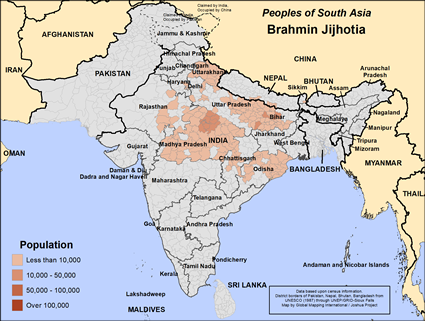Brahmin Jijhotia in India

Photo Source:
Anonymous
|

Map Source:
People Group data: Omid. Map geography: UNESCO / GMI. Map Design: Joshua Project.
|
| People Name: | Brahmin Jijhotia |
| Country: | India |
| 10/40 Window: | Yes |
| Population: | 503,000 |
| World Population: | 504,500 |
| Primary Language: | Hindi |
| Primary Religion: | Hinduism |
| Christian Adherents: | 0.00 % |
| Evangelicals: | 0.00 % |
| Scripture: | Complete Bible |
| Ministry Resources: | Yes |
| Jesus Film: | Yes |
| Audio Recordings: | Yes |
| People Cluster: | South Asia Forward Caste - Brahmin |
| Affinity Bloc: | South Asian Peoples |
| Progress Level: |
|
Introduction
The Jijhotia are a group of Brahmins residing in northern and central India. Brahmins continue to follow the traditional four stages of life. The first stage is that of a student, succeeded by the householder stage, where one's main responsibilities include marriage, raising a family and contributing to society. After children are married, individuals enter the third stage of reclusiveness, focusing on spiritual concerns. The final stage, which the people rarely practice, involves itinerant and homeless wandering.
Ministry Obstacles
There may be no Christ followers among the Jijhotia Brahmin. They know that becoming a Christian will mean losing much of their high status. Few would dare to take this step. Early on, Jesus' disciples only understood him to be a teacher. It wasn't until late in his ministry that most of them understood his lordship. Brahmins will also need to learn who Jesus is, one step at a time.
Outreach Ideas
Pray for the Followers of Christ
Pray for the Entire People Group
Pray for Christ to reveal himself to Jijhotia Brahmins.
Pray for the eyes of Brahmin hearts to be open to Jesus Christ as Lord and King.
Pray for Christ followers, guided by the Spirit, to go to Jijhotia Brahmin communities.
Pray for many to be prompted to faithfully pray for Jijhotia Brahmins.